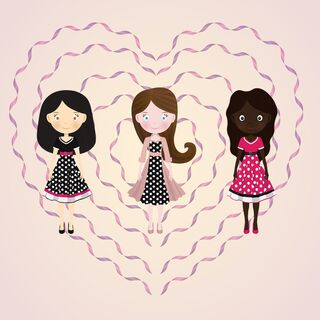Bias
Courageous Conversations
Helping your child understand race and racism.
Posted August 1, 2020 Reviewed by Gary Drevitch

“Daddy, look! There’s a brown lady.” The blonde-haired, blue-eyed toddler yelled and pointed at me as he sat in his shopping cart. After an awkward second or two of silence followed by a nervous chuckle, the boy’s father told his son that it is rude to point at strangers. As they continued down the narrow aisle quickly strolling past me, I realized that it was difficult to determine the underlying tone of the brief encounter: Was it an early expression of bias that the child was exhibiting or did it represent just an interested toddler’s curiosity about obvious outward differences between humans? I ultimately decided that in either case, the interaction could have been an important “teachable moment” for the child instead of the awkward one we all shared had it been handled more effectively. As I walked down the aisle of our neighborhood home improvement store to continue my shopping, I played out different scenarios in my head of what a healthy conversation about race and racial differences could and should look like with a young child of that age.
As our nation grapples with recent traumatic examples of racial injustice and police brutality against persons of color, these kinds of conversations are happening more and more. Peaceful protests, and sometimes not so peaceful displays of racial despair and desperation, have stirred up overwhelming emotions in many of us. As we begin the process of searching for collective understanding, many parents realize the importance of not only processing their own feelings about race and racism but also of helping their children process these events and their feelings, too.
We have been asked by many white parents how to talk to their kids about race and racism. Here are a few questions that we have encountered, with our responses:
Isn’t it best to simply teach your children that race doesn’t matter at all and raise them up to not even pay attention to race?
- It is tempting to believe that statements like “I don’t even see race” or “I am color blind, I take each person individually” are somehow positive statements. They are not. Statements like these would have everyone ignore the richness in diversity that we all benefit from by being from different groups.
- There is nothing inherently bad about racial and ethnic differences and the cultural and traditional embodiment of such. These differences should be celebrated and not brushed under the rug.
- Statements like these are invalidating to all persons who should and do take pride in their own roots.
How early should I talk to my kids about racial differences and racism?
- A baby’s brain can begin to notice race-based phenomenological differences at six months. But just because they notice differences at this age doesn’t mean that they have formed biases. That comes much later.
- Sociologists and social psychologists have found that racial stereotypes and biases begin to be internalized during the toddler years. Children as young as age two start demonstrating the racial preferences and biases that they have been taught. Therefore, it is important to start having talks about racism early in your child’s development.
- Talking to your kids about racism not only requires an early introduction but also frequent conversations to address ongoing questions and areas of concern or interest that may arise as they interact with other children of different races.
In young children, what are the best ways to introduce the concept of racism?
- As a parent, first ensure that you have an accurate understanding of the concept of institutional racism. Institutional racism takes a longitudinal look at how Blacks and other groups of color were oppressed over many, many generations in the past and how the consequences of those unjust practices persist well into the 21st century. They show up as wealth gaps, health disparities, educational disparities, career attainment disparities, redlining, environmental racism, criminal justice disparities, crime disparities, gang violence, food deserts, and more. All of these phenomena didn’t just materialize out of nowhere. They are a consequence of historical injustices that have never been fully addressed. It may be easy as a white person to not be aware of or to not be fully conscious about those connections and so the process of self-education is critical.
- Once you have become knowledgeable, only then can you have an honest conversation about our country’s serious ongoing problems of racism, oppression, and unconscious bias. This is the ugly reality. Plain and simple.
- Developmentally appropriate books, television shows, and movies are an excellent way to introduce the concept of racism to younger children.
What specifically can parents do to raise anti-racist kids?
- Teach your children to notice and value differences in race and culture. For example, make positive and affirming statements about your child’s playmates of different racial and ethnic groups. Celebrate and affirm differences.
- Introduce your child to different races and cultures with real-world experiences. For example, take family outings to cultural museums, dine at restaurants with different cultural cuisines, or go to movies that highlight issues of race and culture.
- Share stories with your kids regarding people of color that highlight positive, human characteristics such as kindness, respect, compassion.
- Teach your child what it is to be an ally. Encourage participation in groups that support the causes and interests of minority groups.
- Start the conversations of race and racism and keep them going. Emphasize that you have created a safe space to have regular discussions with your child about race and racism.
Talking about race and racism with our children may be anxiety-provoking, awkward, or uncomfortable. Yet it is critically important that parents have these meaningful discussions to help their kids foster healthy attitudes on race and to ensure that we progress as a society by eliminating racial injustice for future generations.


